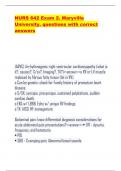NURS 642 Exam 2. Maryville
University. questions with correct
answers
(ARVC) Arrhythmogenic right ventricular cardiomyopathy (what is
it?, causes?, S/sx?, Imaging?, TX?)>>answe>>>o RV or LV muscle
replaced by fibrous fatty tissue (1st in RV).
o Can be genetic: check for Family history of premature heart
disease.
o S/SX: syncope, presyncope, sustained palpitations, sudden
cardiac death.
o EKG w/ LBBB. Echo w/ unique RV findings.
o TX: AICD, HF management.
Abdominal pain: know differential diagnosis considerations for
acute abdominal pain presentations?>>answe>>>• UTI - dysuria,
frequency, and hematuria
• PID
• SBO - Cramping pain. Abnormal bowel sounds.
,• Ovarian Torsion
• Muscle strain
• Nephrolithiasis
• Mesenteric ischemia - high intensity pain. Chronic pain that
usually starts within one hour of eating.
• IBS - swings between diarrhea and constipation.
• GERD/PUD - burning or gnawing pain
• Intrauterine pregnancy
• Herpes zoster infection
• Gastroenteritis - Colicky pain
• Ectopic pregnancy
• Diverticulitis - most common cause of LLQ pain in adults.
• Liver disease
• Crohn disease
• Cholecystitis - RUQ pain.
• Appendicitis - most common cause of RLQ pain requiring
surgery.
• Acute pancreatitis - RUQ pain that radiates to the back. Pain is
gradual and steady. Classically relieved by sitting up and leaning
forward.
• Peritonitis - Pain comes on sudden and severe. Motion causes
pain. Rebound tenderness. Abdominal rigidity.
• Abscess
• Bowel perforation.
,• Renal colliculi - pain radiates to groin. high intensity pain.
Other:
• Because hepatic pain only results when the capsule of the liver is
"stretched," most pain in the right upper quadrant is related to the
biliary tree.
• A patient taking corticosteroids may have significant masking of
pain.
• Older adult patients often present with less intense pain.
Acute hepatitis A (HAV) (In Depth)>>answe>>>o Transmitted:
through ingestion of fecal matter (close contact, sexual contact,
ingestion of contaminated food/drink).
o Most are asymptomatic.
Characteristics - abrupt or insidious with malaise, myalgia,
arthralgia, fatigue, URI, anorexia, nausea, vomiting, fever, RUQ pain,
jaundice, hepatomegaly, liver tenderness,
o Preventive measures include vaccination, proper hand hygiene,
and proper food handling, as well as disinfection of contaminated
surfaces.
o Testing:
If IgM (-) but IgG (+) = immune to HAV.
If IgM (+) but IgG (-) = Acutely infected with HAV.
, WBC, large, typical lymphocytes, ALT/AST elevation, bili/alk phos
elevation, anti-HAV, Detection of IgM anti-HAV is an excellent test
for diagnosing acute hepatitis A but is not recommended for the
evaluation of asymptomatic persons with persistently elevated
serum aminotransferase levels because false-positive results
occur, RA meds will give false negatives.
Acute hepatitis A (HAV) (Quick)>>answe>>>• Early S/Sx: Anorexia,
N/V, malaise, dislike to smoking.
• Other S/Sx: Fever, enlarged and tender liver, jaundice.
• Will have normal to low WBC's.
• Will have markedly elevated Aminotransferases.
Acute hepatitis B (HBV) (In Depth)>>answe>>>o Transmitted:
through infectious blood, semen, and bodily fluids via percutaneous
or mucosal exposure. most common modes of HBV transmission
are sexual contact and injection drug use.
o Acute HBV infection most often resolves completely and confers
lifelong immunity, but in up to 2% of cases, infection results in
fulminant hepatitis, which has a case fatality rate of 63% to 93%.
o Acute HBV progresses to chronic infection in about 90% of
infants infected at birth.
o HBV is considered hardy and remains infectious outside the body
for about seven days.




